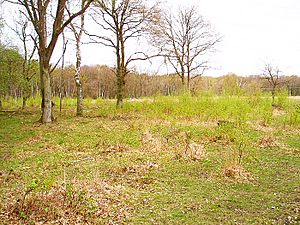Hook Common and Bartley Heath facts for kids
| Site of Special Scientific Interest | |

Hook Common
|
|
| Area of Search | Hampshire |
|---|---|
| Interest | Biological |
| Area | 129.4 hectares (320 acres) |
| Notification | 1991 |
| Location map | Magic Map |
Hook Common and Bartley Heath is a very special natural area in Hampshire, England. It covers about 129.4 hectares (that's like 320 football fields!). This important place is officially known as a Site of Special Scientific Interest, or SSSI for short. It has been protected since 1991.
This amazing site is looked after by the Hampshire and Isle of Wight Wildlife Trust. They work hard to keep it a safe home for many different plants and animals.
Contents
Why is Hook Common and Bartley Heath Special?
Hook Common and Bartley Heath is important because of its unique natural features. It has large areas of "wet heath," which is a type of land that is quite rare. This kind of habitat is especially hard to find in the Thames Basin area.
What is a Site of Special Scientific Interest (SSSI)?
A Site of Special Scientific Interest (SSSI) is a protected area in the United Kingdom. These places are chosen because they have important wildlife, plants, or geological features. Protecting them helps make sure these special parts of nature can survive and thrive for the future.
Exploring the Habitats
Besides the rare wet heath, Hook Common and Bartley Heath also has areas of "dry heath." This means some parts of the land are drier, supporting different kinds of plants. You can also find woodlands here, with trees like oak and birch. These different habitats create a rich environment for many creatures.
Wet Heath: A Rare Treasure
Wet heath is a type of open land that stays damp or wet for most of the year. It's usually found in places with poor drainage. This habitat is very special because it's home to unique plants and animals that need these specific conditions to live. It's rare in the Thames Basin because many similar areas have been changed by human activity.
Amazing Wildlife: Insects and More
Hook Common and Bartley Heath is buzzing with life, especially tiny creatures! It has a rich collection of invertebrates. Invertebrates are animals without backbones, like insects, spiders, and worms.
Rare Moths and Hoverflies
Among the many insects, you can find some very rare ones here. Two types of moths, Stenoptila graphodactyla and Idaea dilutaria, live at Hook Common. These moths are listed in the Red Data Book. The Red Data Book is a list of species that are at risk of disappearing from the world.
Another special insect found here is the hoverfly Microdon mutabilis. Hoverflies are insects that look a bit like bees but are actually flies. They are important for pollinating plants. Finding these rare species shows how important Hook Common and Bartley Heath is for protecting biodiversity.

